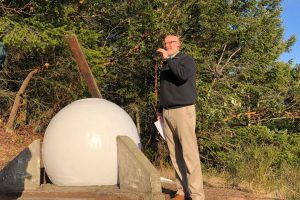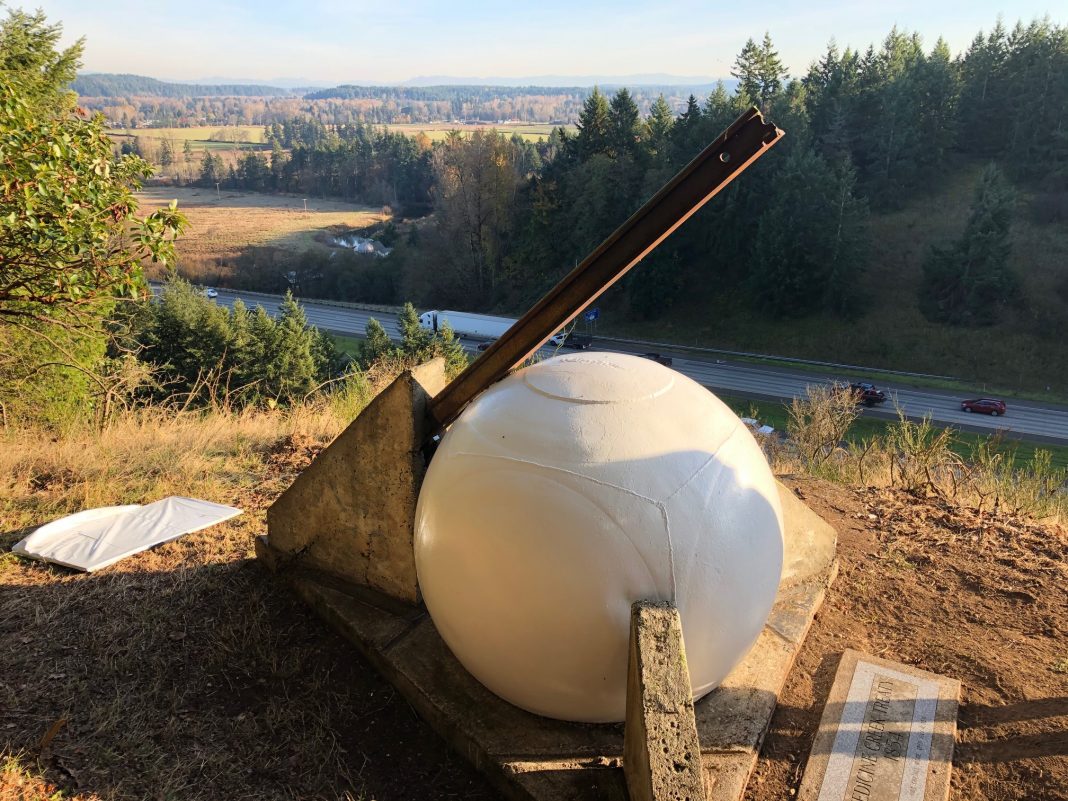Past and present students and teachers of Timberline High School along with other community members gathered Monday, November 4, 2019 at the Medicine Creek Treaty Memorial for the first of several events commemorating Timberline High School’s 50th Anniversary. The school began as an innovative open concept school with no walls in the fall of 1969. Students studying native cultures designed and created the memorial in 1976 as part of the United States Bicentennial.
 Wall-less classrooms didn’t last at Timberline. “It was an amazing experience and it was a great idea, but it didn’t work” said Sharon Thomas, former teacher and “founding mother” of Timberline High School. “Particularly for people who have hearing problems.” But opening minds and reaching out to communities surrounding the school is a tradition that has carried on.
Wall-less classrooms didn’t last at Timberline. “It was an amazing experience and it was a great idea, but it didn’t work” said Sharon Thomas, former teacher and “founding mother” of Timberline High School. “Particularly for people who have hearing problems.” But opening minds and reaching out to communities surrounding the school is a tradition that has carried on.
Sharon was one of several teachers who taught a Native American Studies class. “We did all kinds of things that worked in the community as well as in the school,” she shares. Students got credit for composition and for social studies. “We read and we wrote and we talked.” With the help of local tribal members, the students explored traditional clothes and even held potlatches and pow wows. It was an interactive experience.
“I think it’s left a mark on me as a teacher more than any other course I taught because it made me look at somebody else’s ideas,” Sharon added. “And what happened to those people, it was a very, very sad thing.”

“For 50 years Timberline has been providing opportunities for kids to learn and explore and really see how they can make a difference in the world,” said Timberline Principal Paul Dean in his speech at the event. “In 1976 this monument was put here and this is something that is very uniquely Timberline and really speaks to the spirit of the school and the history of the school.”
Celeste Emmons is a current teacher at Timberline and also happens to be one of the students involved in creating the memorial back in 1976. She took the Native American Studies class and helped gather materials for the time capsule placed beneath it. This year she helped prepare the memorial for this celebration by asking WADOT to mow a path along the ridge for easier access. She and other volunteers cleaned the brush from the base of the monument and gave the sphere a fresh coat of white paint.
Timberline junior and Class President, Natalie Scott, was asked by Dean to give a speech at the ceremony. She spoke of current and former teachers, broken treaties, the struggles of Native Americans, concerns about the environment, what led the students at Timberline to build the monument in 1976, and what it symbolizes. “The process has been wonderful,” Natalie said. “We all have a voice, we all decide how to use it…the choice it not if you want to make an impact, it’s what that impact is going to be.”
The monument seems a simple structure but it has layers of meaning. The circle depicts the native concept of our interconnection to all things. The railroad tie conveys the linear, industrial society that claimed the area in the 1850s. In their project proposal, the designers stated, “We seek to show a perfect harmony, balance and peace.”
The tip of the V-shaped structure points to the place in the valley below where the original Medicine Creek Treaty Tree once stood. The hillside was completely barren back in the 1970s, but new trees were planted and a forest has since grown up from Nisqually Reach. Today, the site of the Treaty Tree is no longer visible from the monument. However, the young forest could be interpreted as a sign of hope.
Sharon Thomas addressed the crowd at the end of the ceremony. “We are all people together,” she said, “and that is a wonderful thing.”
































































